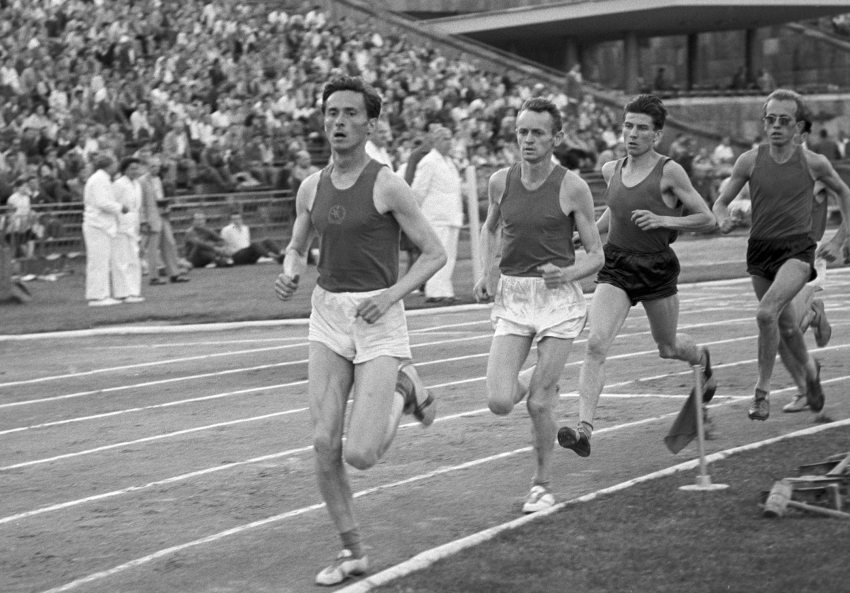World success chased him in vain, never caught up with him – Sándor Iharos, a runner who was faster than everyone
It is said that in Hungary in the 1950s, Sándor Iharos was to athletics what Ferenc Puskás was to football. In 1955, he was voted the world's best athlete by foreign sports journalists, even though he had never been on the podium at a major world competition. Nobody will ever take away from him the fact that he set twelve world records in the middle and long distance races, but the year 1956 took everything else away from him. What exactly was going on in his mind, we don't know, but his dreams were shattered forever.

Cold training sessions, heated successes
He would be ninety-four were he still among us, but similarly to his speed on the track field, he reached his death earlier than others. Sándor Iharos became a world-class athlete even though he only started running seriously at the age of 20 - as his legendary coach Mihály Iglói put it, he was just a jogger before that. Under Iglói's tutelage, Iharos, along with István Rózsavölgyi and László Tábori, became a top-class athlete.
All three of them endured the hardship: the four to five hours of running each day that the Finland-trained coach demanded of his students without compromise. For him, there was only hard training, and many of the runners were injured by the pace he demanded, but those who didn't were the best. Iharos recalled: 'We were lucky. All three of us had loose, fibrous muscles and excellent joints that could withstand the agony of years of tremendous amounts of monotonous work."
The agony is well illustrated by a story written by András Kő in Magyar Nemzet magazine: "István Rózsavölgyi remembers running on Margaret island in the winter of 1955. But it was so cold that their breath froze on their faces. They literally refused to do any work that day. But Coach Iglói sat down on a snowbank and declared that he would not get up until Iharos and the others had finished their daily rations. They grabbed him, took him into one of the buildings and started running."
Thanks to this hard work, in 1955 and '56 Sándor Iharos had the best results in the world in all distances from 1500 metres to 10,000 metres, a performance that no other athlete has ever come close to.
That is why he and the public experienced what happened before, during and after the 1956 Melbourne Olympics as a tragic turn of events. Before the Games, even the Saturday Evening Post had predicted that Hungarian runners would be in the race for at least three or four gold medals, with Iharos a massive favourite in the 10,000 metres.
In the latter distance, on 15 July 1956, in the Népstadion, amidst the applause of 40,000 Hungarian fans, he set a world record: he beat Emil Zátopek's record by 12 (!) seconds. Even his defeated Czech rival congratulated him: "I have a feeling that Iharos will compete at 10,000 metres in Melbourne and the record of that distance will only stand until then," he said. And the Magyarország (Hungary) newspaper later wrote: "For the first time since the miracle runner Nurmi, there was once again an athlete on the globe who could call himself the holder of the 1500, 5000 and 10,000 metres world records at the same time".
Revolution and love swept everything away
Time magazine published a piece entitled Five Comrades about the fearsome Hungarian running team coached by Iglói as the world's best 1500m relay team. Iharos, who raced for Honvéd (Sports Club of the Military Forces), was portrayed as a thin, bony-faced Hungarian lieutenant who was not a member of the Communist Party and who, according to him, "had everything he knew about Marxism drummed into him at school". The article notes that "we can say goodbye to communist heroes" and describes Iharos as "In sport-happy Hungary, the atmosphere heats up when he shakes off his sweats and goes for a run."
However, after all these great expectations, the Hungarian revolution broke out in the autumn of 1956, ending Iharos's rising hopes – although we will never know the exact causes and events. One thing is certain: he had previously been suffering from an injury, but everyone was sure he would make it to the Olympics, he was nominated to the Olympic team. The Games were held in late November or early December that year, in line with the weather in the southern hemisphere, but Iharos did not attend the training camp in Tata in October, as his team-mate István Rózsavölgyi recalled in an interview with Napi Magyarország magazine in 1998.
"We came up to Pest for him on 23 October, and that's how we got caught up in the revolution.
So, we saw the Stalin monument fall, but we didn't find Iharos.
We couldn't go back to the training camp in Tata, so we took shelter on the Honvéd sportsfield at Tüzér street. I tried to train, but without much success, because I was shot at from outside. When did I see Iharos again? We went to Prague by bus at the end of October, and once, probably in a car carrying our equipment, Sanyi (Sándor) arrived. I didn't attend the meeting where he announced that he didn't want to compete in the Olympics, but would only travel to Melbourne as a correspondent. He was not allowed to do so, so he did not board the plane with us."
In another interview with National Sport in 1998, Rózsavölgyi also shared why they had to search high and low for Iharos: "He fell in love, disappeared for weeks, didn't even train (...) On the one hand, he wanted to qualify for the Melbourne Olympics at all costs, but at the same time he was scared because he didn't train, he missed out on a lot of training sessions. He obviously didn't want to get embarrassed." He said this of Iharos’s personality: "Exceptional talent, sensational qualities, combined with a peculiar and sometimes completely incomprehensible nature. He was loved by many, his greatness was acknowledged, but he had no real friends."
"It could have been our successful Olympics Games in 1956, but the revolution disrupted our preparations both mentally and physically" - István Rózsavölgyi also said this to Új Magyarország magazine in 1997. The best result in Melbourne was achieved by László Tábori, who finished fourth in the 1500 metres.
On 31 October 1956, Sándor Iharos himself justified his resignation from the Olympics in the then Népszava newspaper, thus: "I will not participate in the Olympics because I feel that I am out of shape. Since I cannot in good conscience promise to perform as expected, I have decided to cancel the trip. The huge amount of dollars that would have been spent on sending me abroad should be rather spent on medicine, and saving the lives of my countrymen wounded in the struggle for freedom."
Later, however, he followed the others to Prague, and asked the delegation's revolutionary committee to allow him to accompany the delegation to Melbourne as a sports journalist. The committee insisted that he should run, but he refused. He reportedly lost a lot of weight, and the final word was given by Coach Iglói, who, according to National Sport, sent him home.
And how did love come into the picture as a possible motive? According to many, Iharos would have been willing to compete in the Olympics only if his love, the javelin thrower Ilona Laczó, could also go. The two were married in 1957, and she told a journalist of Napi Magyarország in 1998: "It is not true that at the training camp in Prague Sanyi said he would only go to the Olympics if they took me. He couldn't have demanded such a thing, because although I had won the Hungarian and English championships in javelin throwing, I was not among the top international athletes in 1956. But it is undeniable that he came home from Prague because of me, and we left the country together after the revolution."
He was sensitive and quietly gave up
Iharos accepted a contract from a Belgian club, among several offers from abroad, and married Ilona Laczó in Belgium, who recalled the period: "We got everything we needed there, an apartment, a car and a proper job, and we both started learning French.
Despite the excellent opportunities, Sanyi became increasingly tense and homesick.
So in the spring of 1957 he decided to come home. The Belgians, of course, did not understand, articles appeared saying that the Red Runner was going back behind the Iron Curtain. But nothing prevented Sanyi from returning to his homeland. Believe me, if we had stayed in Belgium, his sporting career and his life would have been completely different."
Iharos said in an interview in May 1957: "I can only say what all returnees say: we regret leaving the country. We both missed home, our relatives, the whole country more and more." Back in Hungary, the couple, along with their regrets, were welcomed with open arms.
After returning home, the sportsman started training again, but without the training of Mihály Igló, who had emigrated to the USA, he could not even come close to his former self: he competed in the 1960 Rome Olympics, but did not even come close to the podium. In 1963 he became the athletics coach of the Central Sports School (KSI), then in 1966 he divorced his wife and later worked as a petrol station attendant and grocer. He turned to drink to escape his deepening depression and died of heart failure at the age of 66. According to his son, Sándor Iharos Jr.
"He quietly gave up. (...) He didn't want to fight any more."
Ilona Laczó remembered her former partner: "After we got divorced, we kept in touch (...) He was extremely sensitive and he couldn't seem to bear the fact that, despite running a dozen world records, he couldn't achieve on competitions what he was capable of. And in his life outside the track, he was simply a failure. And believe me, he was a man of great integrity and warmth. I can honestly say –not as an ex-wife, but as a former athlete –, that there has never been, and never will be, another Hungarian runner as outstanding as Sándor Iharos. Therefore he deserves all respect."
For his 1955 performance, Sándor Iharos earned the World Trophy, founded by the Helms Foundation in 1936, which he was awarded as the best in Europe. According to many Hungarian sources, the AP news agency also voted him the best in the world, but this was in fact done by a Swedish newspaper, Ny Tid: at the newspaper's request, nearly fifty journalists from different continents voted, and Iharos came out on top. In Hungary, the name of this outstanding runner is commemorated by a stamp, a memorial race and the Honvéd athletics stadium in Budapest.
Resources used:
https://pestisracok.hu/otvenhatban-tort-ossze-a-futozseni-iharos-sandor-alma-egy-legendas-rejtely-avagy-ikarosz-zuhanasa/
https://hu.wikipedia.org/wiki/Iharos_S%C3%A1ndor
https://www.magyarhirlap.hu/sport/20200317-a-futokiralyt-nem-koronazhattak-meg-melbourne-ben
https://168.hu/sport/iharos-kiraly-korona-nelkul-felejthetetlen-sportolok-elfelejtett-tortenetek-188284
https://magyaredzo.hu/viharos-eletmu-kilencven-eve-szuletett-a-futozseni-iharos-sandor/







